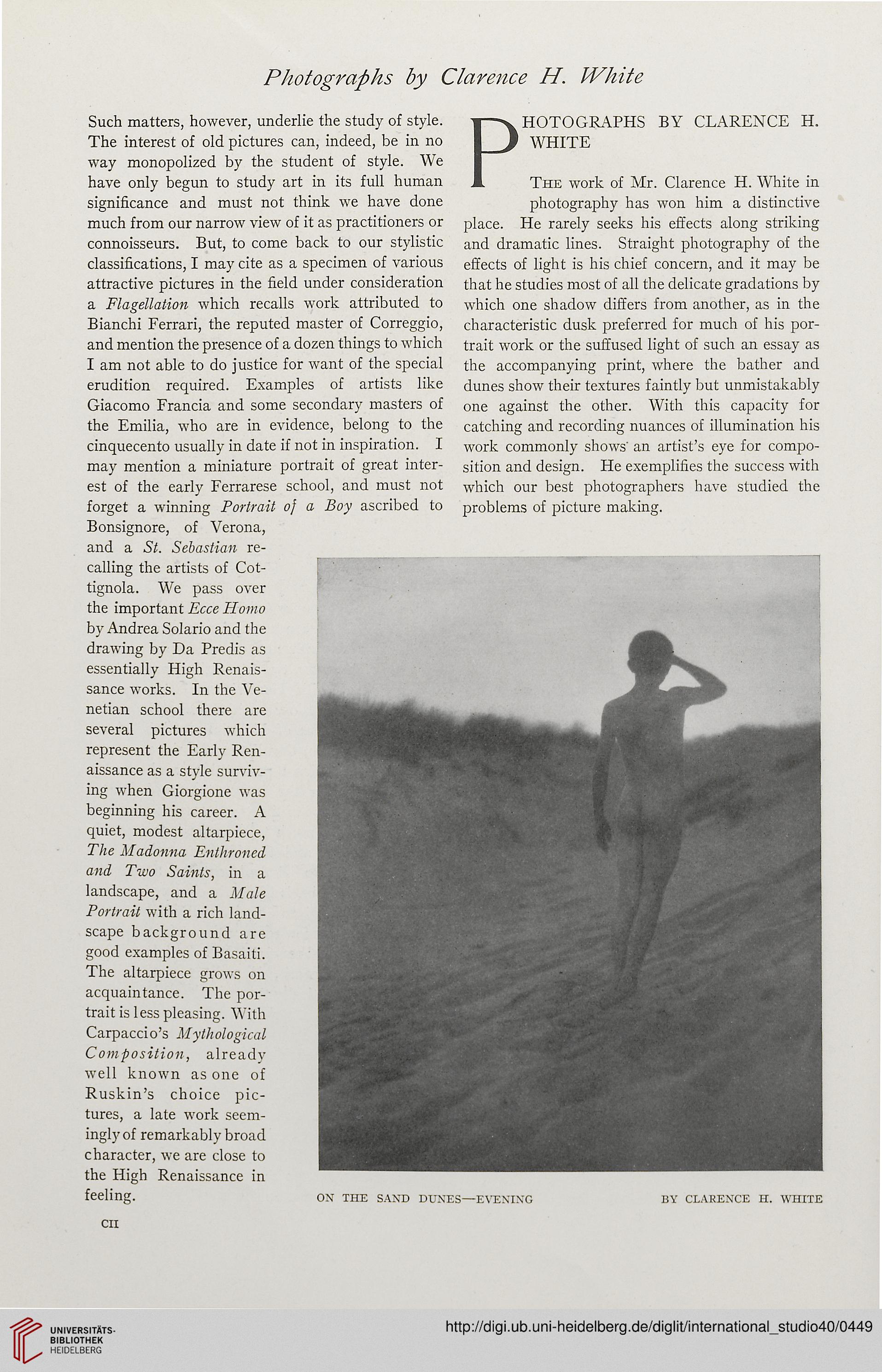Photographs by Clarence H. White
Such matters, however, underlie the study of style. |—«vHOTOGRAPHS BY CLARENCE H.
The interest of old pictures can, indeed, be in no I 1 WHITE
P
way monopolized by the student of style. We
have only begun to study art in its full human J| The work of Mr. Clarence H. White in
significance and must not think we have done photography has won him a distinctive
much from our narrow view of it as practitioners or place. He rarely seeks his effects along striking
connoisseurs. But, to come back to our stylistic and dramatic lines. Straight photography of the
classifications, I may cite as a specimen of various effects of light is his chief concern, and it may be
attractive pictures in the field under consideration that he studies most of all the delicate gradations by
a Flagellation which recalls work attributed to which one shadow differs from another, as in the
Bianchi Ferrari, the reputed master of Correggio, characteristic dusk preferred for much of his por-
and mention the presence of a dozen things to which trait work or the suffused light of such an essay as
I am not able to do justice for want of the special the accompanying print, where the bather and
erudition required. Examples of artists like dunes show their textures faintly but unmistakably
Giacomo Francia and some secondary masters of one against the other. With this capacity for
the Emilia, who are in evidence, belong to the catching and recording nuances of illumination his
cinquecento usually in date if not in inspiration. I work commonly shows' an artist's eye for compo-
may mention a miniature portrait of great inter- sition and design. He exemplifies the success with
est of the early Ferrarese school, and must not which our best photographers have studied the
forget a winning Portrait of a Boy ascribed to problems of picture making.
Bonsignore, of Verona,
and a St. Sebastian re-
calling the artists of Cot-
tignola. We pass over
the important Ecce Homo
by Andrea Solario and the
drawing by Da Predis as
essentially High Renais-
sance works. In the Ve-
netian school there are
several pictures which
represent the Early Ren-
aissance as a style surviv-
ing when Giorgione was
beginning his career. A
quiet, modest altarpiece,
The Madonna Enthroned
and Two Saints, in a
landscape, and a Male
Portrait with a rich land-
scape background are
good examples of Basaiti.
The altarpiece grows on
acquaintance. The por-
trait is less pleasing. With
Carpacci o's Myth ological
Composition, alreadv
well known as one of
Ruskin's choice pic-
tures, a late work seem-
ingly of remarkably broad
character, we are close to
the High Renaissance in
feeling. on the sand dunes—evening by clarence h. white
cn
Such matters, however, underlie the study of style. |—«vHOTOGRAPHS BY CLARENCE H.
The interest of old pictures can, indeed, be in no I 1 WHITE
P
way monopolized by the student of style. We
have only begun to study art in its full human J| The work of Mr. Clarence H. White in
significance and must not think we have done photography has won him a distinctive
much from our narrow view of it as practitioners or place. He rarely seeks his effects along striking
connoisseurs. But, to come back to our stylistic and dramatic lines. Straight photography of the
classifications, I may cite as a specimen of various effects of light is his chief concern, and it may be
attractive pictures in the field under consideration that he studies most of all the delicate gradations by
a Flagellation which recalls work attributed to which one shadow differs from another, as in the
Bianchi Ferrari, the reputed master of Correggio, characteristic dusk preferred for much of his por-
and mention the presence of a dozen things to which trait work or the suffused light of such an essay as
I am not able to do justice for want of the special the accompanying print, where the bather and
erudition required. Examples of artists like dunes show their textures faintly but unmistakably
Giacomo Francia and some secondary masters of one against the other. With this capacity for
the Emilia, who are in evidence, belong to the catching and recording nuances of illumination his
cinquecento usually in date if not in inspiration. I work commonly shows' an artist's eye for compo-
may mention a miniature portrait of great inter- sition and design. He exemplifies the success with
est of the early Ferrarese school, and must not which our best photographers have studied the
forget a winning Portrait of a Boy ascribed to problems of picture making.
Bonsignore, of Verona,
and a St. Sebastian re-
calling the artists of Cot-
tignola. We pass over
the important Ecce Homo
by Andrea Solario and the
drawing by Da Predis as
essentially High Renais-
sance works. In the Ve-
netian school there are
several pictures which
represent the Early Ren-
aissance as a style surviv-
ing when Giorgione was
beginning his career. A
quiet, modest altarpiece,
The Madonna Enthroned
and Two Saints, in a
landscape, and a Male
Portrait with a rich land-
scape background are
good examples of Basaiti.
The altarpiece grows on
acquaintance. The por-
trait is less pleasing. With
Carpacci o's Myth ological
Composition, alreadv
well known as one of
Ruskin's choice pic-
tures, a late work seem-
ingly of remarkably broad
character, we are close to
the High Renaissance in
feeling. on the sand dunes—evening by clarence h. white
cn




